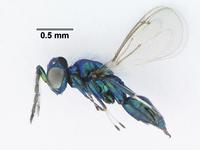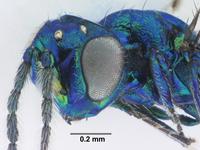Bob Suchanek, Water and Wetlands Steward


Chalcid Wasps (Fairy Wasp Relatives)
Photo Credit – National Park Service Public Domain Images
“Do you believe in fairies? Say quick that you believe. If you believe, clap your hands!”
James M. Barrie, Peter Pan
Fairy Wasp Family Ties
For the last couple of weeks I’ve been learning about the incredible beings called fairy wasps. I have yet to see one alive! Well, maybe I have but didn’t know it since they could be mistaken for some other small insect, perhaps a gnat. It’s hard to get used to get used to thinking that a wasp can be nearly as small as a period.
Fairy wasps are non-stinging wasps in the superfamily Chalcidoidea and family Mymaridae; scientific terms with Greek roots coined in the 19th century that mean “metallic” (Chalcidoidea) and “spot” (Mymaridae). The superfamily is huge, with over 500,000 species and 19 families worldwide. The fairy wasp “spot” family has about 1,400 species.
Tinkerbell’s Family
Fairy wasps are very small, with body lengths ranging from about the width of a human hair to a relatively gigantic three eighths of an inch. A microscope is required to appreciate their waspish nature and under magnification all of the characteristics expected of a member of the ant/bee/wasp order are revealed.
The smallest fairy wasps are multicellular animals sized like single-celled organisms! Although they seem strange they’re widely distributed and quite common. One of the smallest species is Tinkerbella nana:
https://phys.org/news/2013-05-tinkerbella-nana-species-fairyfly.html
The size and number of fairy wasp cells is reduced but the necessary waspish skills and behaviors are intact. Even with nervous systems reduced to just hundreds of tiny cells flight is possible; however, air is resistant and at the tiny scale flight is more like rowing and wings are more like oars.
Short Lives and Stolen Eggs
The life of a fairy wasp is brief, perhaps only a day or two and certainly less than a dozen days. A wasp’s life begins as a very tiny egg deposited by a tiny female in the much larger egg of another insect. The larvae that emerge in the stolen egg dine at the egg owner’s expense, terminating development of the host species. This parasitoid behavior has been recognized by plant care professionals as a way to control harmful insect species. For example, a fairy wasp species native to Minnesota has been recognized as a potential control agent for an insect that spreads a bacterial grape infection in California vineyards.
Where to Look for a Fairy Wasp
Like other flying insects, fairy wasp adults need energy. This makes nectar rich flower beds good places to look for them. It’s also been suggested that an infestation of destructive insect pests might be an opportunity to see fairy wasps as they gather to take advantage of egg laying opportunities; fairy wasps aren’t too particular about the species that host their larval young.
I’m going to keep my eyes open for little flying insects, always carry a magnifier, and look before I swat. It’s time to start a fairy wasp life list!
Some additional sources:
Many thanks are due to John Luhman at the University of Minnesota for his fairy wasp insights.